- About Us
- Our Work
- Tree Info
- Get Involved
- Blog
- Support Us
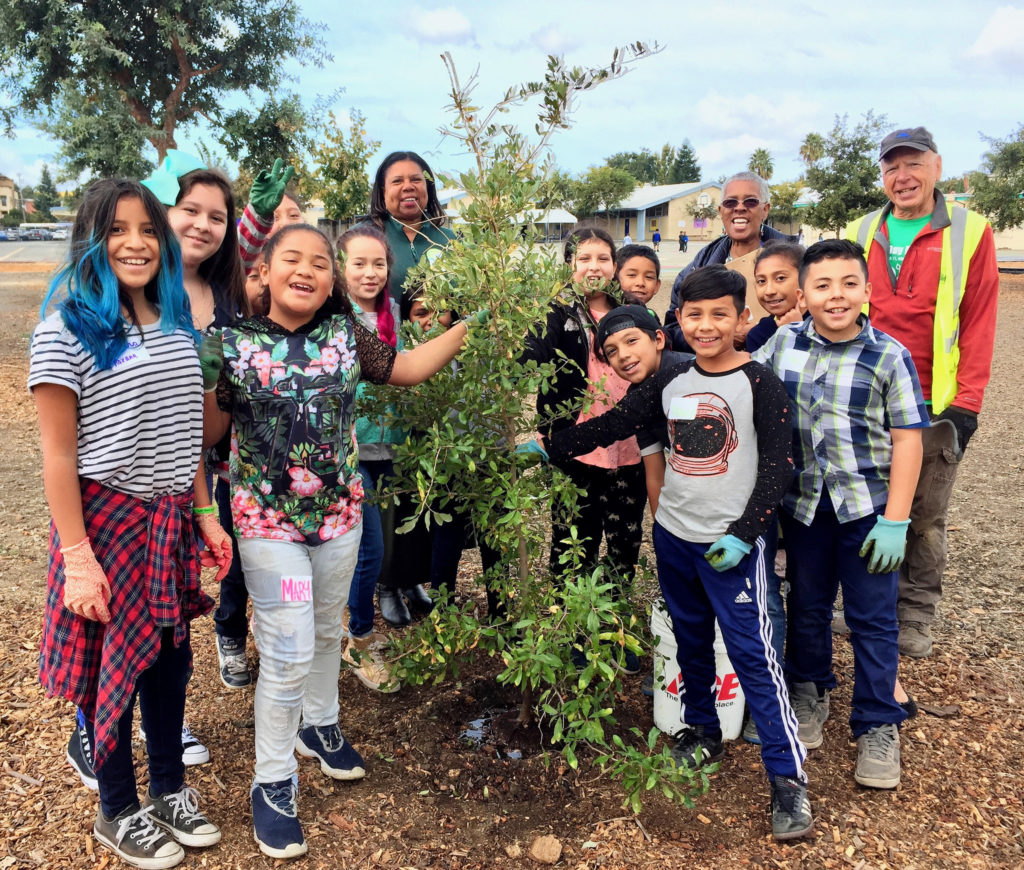
Canopy offers lessons aligned with the Common Core Principles and Next Generation Science Standards. All lessons can be taught either virtually or in person.
Canopy ofrece lecciones alineadas con los Principios de Los Básicos Comunes y los Estándares Científicos para las Próximas Generaciones. Todas las lecciones pueden impartirse o virtualmente o en vivo.
2nd: Portrait of a Tree / Retrato de un árbol
Description: 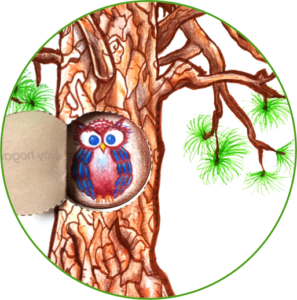 This lesson develops students’ observation and reasoning skills through a “compare and contrast” activity involving plants. They learn firsthand how scientists classify items into categories based on their similarities, while also acknowledging differences between them.
This lesson develops students’ observation and reasoning skills through a “compare and contrast” activity involving plants. They learn firsthand how scientists classify items into categories based on their similarities, while also acknowledging differences between them.
In the second part of this lesson, students observe and draw a tree, modeling specific tree parts (trunk, roots, branches, and leaves), as they discover why each is important for the tree. The in-person lesson finishes with a surprise reveal!
Lesson Summary (includes the standards that this lesson meets)
Post-Lesson Activity: Environmental Champion Challenge, Desafío del campeón ambiental
2nd: Diversi-tree / Diversidad de árboles
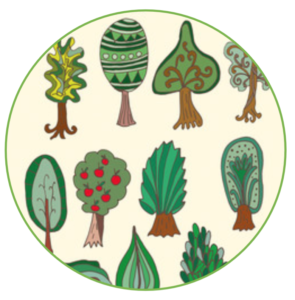 Description: This vocabulary-rich lesson takes students from the mythical land of Dr. Seuss’s truffala trees around the world on an imaginary field trip to explore the diversity of plant and animal species in different habitats. As explorers, they will be tasked with observing the plants and animals of each place, ending with a spotlight on several trees commonly planted in northern California – and which Canopy has planted at many of their school campuses!
Description: This vocabulary-rich lesson takes students from the mythical land of Dr. Seuss’s truffala trees around the world on an imaginary field trip to explore the diversity of plant and animal species in different habitats. As explorers, they will be tasked with observing the plants and animals of each place, ending with a spotlight on several trees commonly planted in northern California – and which Canopy has planted at many of their school campuses!
Students will learn that some places are more diverse than others and that each living thing has a specific habitat in which it thrives. Certain places with high diversity have many species.
Lesson Summary (includes the standards that this lesson meets)
Post-Lesson Activity: Letter to a Tree, Carta a un árbol
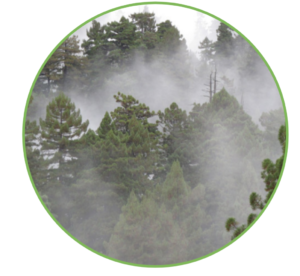
Description: Ever wondered how our trees are able to survive the shock of a hurricane or the inferno of a wildfire? In this lesson, students will explore the phrase “adapt to survive” as it relates to trees and extreme weather/climate conditions. They will use their skills as “actors” to design skits that embody the tree experience and explore the various ways a tree becomes resilient to its harsh environments.
Lesson objective: Students will learn about tree adaptations to extreme weather/climate events through performance activities, outdoor exploration and student-led teaching.
Lesson Summary (includes the standards that this lesson meets)
 Description: Have your students ever marveled at the sheer size of a 40 foot tall tree and wondered where it came from? What could have possibly created something so large? In this lesson, students will learn the life cycle of trees and the stages of growth it takes to become a mature adult tree. Students first develop an understanding for what tree parts appear during different stages of growth. Students will then explore how each of these parts are connected through a life cycle using storytelling, artistic expression, and outdoor exploration.
Description: Have your students ever marveled at the sheer size of a 40 foot tall tree and wondered where it came from? What could have possibly created something so large? In this lesson, students will learn the life cycle of trees and the stages of growth it takes to become a mature adult tree. Students first develop an understanding for what tree parts appear during different stages of growth. Students will then explore how each of these parts are connected through a life cycle using storytelling, artistic expression, and outdoor exploration.
Lesson Summary (includes the standards that this lesson meets)
4th: Tree to Table / De árbol a antojito
Description: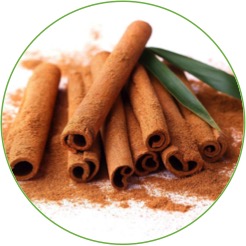 Students explore tree parts in this lesson through a selection of herbs and spices that come from trees. Using a set of cards included in the lesson material, students classify herbs and spices by tree part and function, explaining their reasoning through arguments based on evidence.
Students explore tree parts in this lesson through a selection of herbs and spices that come from trees. Using a set of cards included in the lesson material, students classify herbs and spices by tree part and function, explaining their reasoning through arguments based on evidence.
Given definitions of “weather” and “climate,” students are then asked to think about how these affect where trees can grow. A follow-up comprehension activity asks students to correctly identify tree-derived herbs, spices, and foods from ingredient lists of familiar dishes and beverages.
Lesson Summary (includes the standards that this lesson meets)
Post-Lesson Activity: Environmental Champion Challenge, Desafío del campeón ambiental
4th: Defense Against the Bark Arts / Selección de protección de los árboles
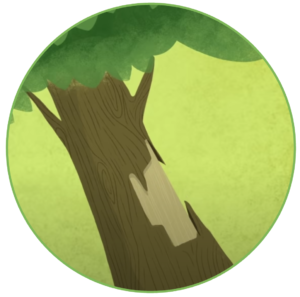 Description: Is it science or is it magic? In this lesson, students learn about the various animals, insects, bacteria, fungi, and pathogens that threaten trees’ survival and how trees defend themselves against attacks using both mechanical and chemical protections. A matching game tests their understanding of different defense mechanisms as they choose from a selection of potential attackers given a photo and brief description of a tree’s defense.
Description: Is it science or is it magic? In this lesson, students learn about the various animals, insects, bacteria, fungi, and pathogens that threaten trees’ survival and how trees defend themselves against attacks using both mechanical and chemical protections. A matching game tests their understanding of different defense mechanisms as they choose from a selection of potential attackers given a photo and brief description of a tree’s defense.
Lesson Summary (includes the standards that this lesson meets)
Post-Lesson Activity: Design a Tree Defense, Answer Key; Diseña una defensa de los árboles, Clave de respuestas
4th: Native Trees and the Web of Life / Árboles nativos y la red de la vida
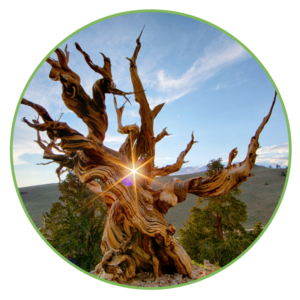 Description: In this game show-style lesson, students will learn about important native trees and their “superhero” adaptations to local weather conditions and resource constraints. Building off of their understanding of trees, students will then complete a Web of Life, linking biotic and abiotic components of the local ecosystem. The Web of Life illustrates the many interconnections of the natural world. Note: This lesson is designed to be taught live on Zoom by a Canopy educator.
Description: In this game show-style lesson, students will learn about important native trees and their “superhero” adaptations to local weather conditions and resource constraints. Building off of their understanding of trees, students will then complete a Web of Life, linking biotic and abiotic components of the local ecosystem. The Web of Life illustrates the many interconnections of the natural world. Note: This lesson is designed to be taught live on Zoom by a Canopy educator.
Post-Lesson Activity: Environmental Superhero Challenge, Desafío de superhéroes medioambientales
Description:
 Fitting within the NGSS 6th grade Integrated Instruction Segment “Effects of Global Warming on Living Systems,” this lesson approaches the topic of climate change from the perspective of trees. Students learn how trees positively contribute to carbon storage, as well as how human actions like deforestation and the combustion of fossil fuels can accelerate climate change.
Fitting within the NGSS 6th grade Integrated Instruction Segment “Effects of Global Warming on Living Systems,” this lesson approaches the topic of climate change from the perspective of trees. Students learn how trees positively contribute to carbon storage, as well as how human actions like deforestation and the combustion of fossil fuels can accelerate climate change.
In the second part of this lesson, students follow instructions to measure a tree, discover the amount of carbon it stores, and compare this to how much carbon our daily activities release.
Lesson Materials:
“Trees & Climate Change” Teacher Instructions
“Trees & Climate Change” Pre-lesson Material
“Trees & Climate Change” Student Material
“Trees & Climate Change” Answer Key
“Trees & Climate Change” Post-Lesson Material: Indigenous History
Climate change can be a heavy topic. Why not play this Climate Board Game after the lesson to remind you of some of the positive actions that YOU can take to protect the climate?
9th-12th: Bol Park Wellness Tree Walk
Learn fascinating facts about trees while practicing nature-based wellness activities in this Wellness Tree Walk filmed in Palo Alto’s Cornelis Bol Park.
Follow along with the video by using this map and list of trees from the walk.
9th-12th: Rengstorff Park Wellness Tree Walk

This Wellness Tree Walk in Mountain View’s Rengstorff Park highlights trees from four different continents. Learn facts like the connection between the carob tree and the weight of diamonds, while also being guided through a series of journaling and reflection activities.
The Rengstorff Park Wellness Tree Walk features an interactive map with 2-5 minute videos at each of the nine trees. It works well on mobile devices. Plan for 45 minutes.
“Trees give peace to the souls of men.”
~Nora Waln
Nature in general, and trees specifically, help us deal with stress. If you find yourself stressed or overwhelmed right now, try doing the simple exercise shown in the video below three times to help you relax and be more at peace.
Tree Bingo / Bingo con árboles
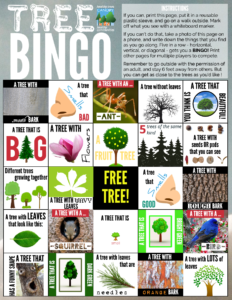 Have you spent too much time on the computer today, or doing classwork indoors? Take a “brain break” outside with this fun Tree BINGO game, appropriate for all ages. Follow the instructions in the PDF to play with – or without! – a printed copy.
Have you spent too much time on the computer today, or doing classwork indoors? Take a “brain break” outside with this fun Tree BINGO game, appropriate for all ages. Follow the instructions in the PDF to play with – or without! – a printed copy.
¿Has pasado demasiado tiempo hoy en la computadora, o haciendo los deberes dentro de casa? Dale a tu seso una siesta, y sal afuera para jugar este divertido juego de BINGO con árboles, apto para todas las edades. Sigue las instrucciones en el PDF para jugar con – ¡o sin! – una copia impresa.
Tree Word Searches / Búsquedas de palabras de árboles
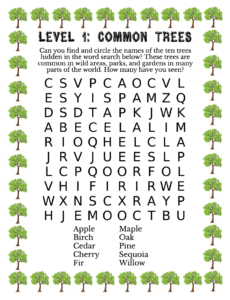 Test your visual skills with these tree-themed word searches for all ages. Use the helpful tree guides included when you’re done to go outside and see how many of the trees you can find in your neighborhood or local park!
Test your visual skills with these tree-themed word searches for all ages. Use the helpful tree guides included when you’re done to go outside and see how many of the trees you can find in your neighborhood or local park!
Level 1 Word Search – Common Trees
Level 2 Word Search – Trees in Your Neighborhood
Level 3 Word Search – Locally Native Trees
Pon a prueba tus habilidades visuales con estas búsquedas de palabras enfocadas en árboles, aptas para todas las edades. Utiliza las guías útiles incluidas al terminar para salir afuera ¡y ver cuántos de los árboles puedes encontrar en tu vecindario o parque local!
Nivel 1 Búsqueda de palabras – Árboles comunes
Nivel 2 Búsqueda de palabras – Árboles en tu vecindario
Nivel 3 Búsqueda de palabras – Árboles localmente nativos
Mystery Box Game / Juego de la caja de misterios
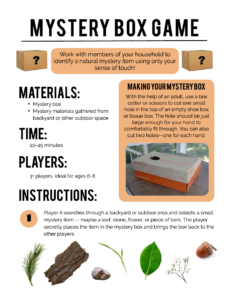
How good are you at guessing? Play this Mystery Box Game outside with 2+ members of your household and see how many fun nature items you can find and guess together. Ideal for ages 6-8.
¿Tienes talento adivinando? Juega este Juego de la caja de misterios al aire libre con 2+ miembros de tu hogar para ver cuántos objetos naturales divertidos pueden encontrar y adivinar juntos. Ideal para edades de 6 a 8.
Leaf Rubbings / Calcos de hojas
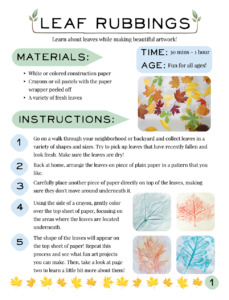
Collect and make beautiful artwork out of leaves with this Leaf Rubbing Activity. Try to match the leaves you’ve collected with the guide of common leaves to see what trees your leaves came from! Fun for all ages.
Recolecta y crea hermosas obras de artes con hojas en este Actividad de calcos de hojas. ¡Intenta emparejar las hojas que has recolectado con la guía de hojas comunes para ver de qué árboles vinieron tus hojas! Divertido para todas las edades.
Transpiration Experiment / Experimento de la transpiración

Ready to ignite your curiosity about nature? Try your hand at this Leaf Transpiration Experiment to learn a tree’s role in the water cycle. And the best part is, you’ll get to see it with your own eyes! For ages 10-12.
¿Listo/a para encender tu curiosidad sobre la naturaleza? Prueba este Experimento de transpiración de las hojas para aprender el papel de un árbol en el ciclo del agua. ¡Y lo mejor es que lo verás con tus propios ojos! Para edades de 10-12.
Spreading Smiles / Compartiendo sonrisas
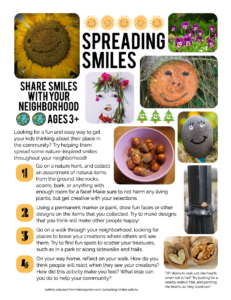
Spread some nature joy with this creative Spreading Smiles craft that is sure to have you – and your neighbors – smiling! For ages 3+.
Difunda un poco de alegría por la naturaleza con esta manualidad creativa Compartiendo sonrisas que seguramente te hará sonreír a ti – y a tus vecinos! Para edades 3+.
Other Resources / Otros recursos
Would you like more resources? See below for science lessons and experiments from other organizations.
¿Le gustaría más recursos? Consulte abajo para lecciones y experimentos de ciencia de otras organizaciones.
Please contact Canopy’s Environmental Educator, Tania Cooley, at [email protected].
Favor de contactarse con Educador Ambiental Tania Cooley a [email protected].
Canopy’s education programs are made possible by the generous support of individual and foundation funders. Would you like to support hands-on nature learning? Make a gift today.
Thank you for your partnership!